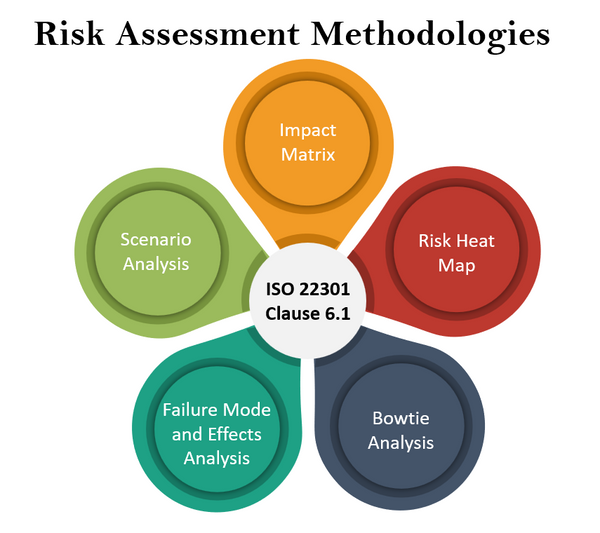ISO 22301 Clause 6.1 Actions to Address Risks and Opportunities
Introduction
Clause 6.1 of ISO 22301 focuses on actions that organizations can take to address risks and opportunities related to their business continuity management system. This clause emphasizes the importance of identifying and addressing risks and opportunities that could impact an organization's ability to continue its critical business activities during a disruption.

Understanding Risks and Opportunities
Understanding risks and opportunities is a critical component of Clause 6.1 in ISO 22301. Risks are defined as potential events or circumstances that can have a negative impact on an organization's ability to achieve its objectives, while opportunities are potential events or circumstances that can have a positive impact on the organization's objectives.
To effectively address risks and opportunities, organizations need to first identify them. This can be done through various means, such as reviewing historical data on past incidents, conducting risk assessments, and consulting with stakeholders.
Once risks and opportunities have been identified, it is important to assess their potential impact and likelihood of occurrence. This can be done through risk assessment methodologies such as the likelihood/impact matrix or the risk heat map.
Identifying Risks and Opportunities
Identifying risks and opportunities is a critical step in addressing them and ensuring the effectiveness of an organization's business continuity management system.
The following are some methods that organizations can use to identify risks and opportunities:
- Review historical data: Organizations can review past incidents, near-misses, and lessons learned to identify potential risks and opportunities.
- Conduct risk assessments: Risk assessments involve identifying potential risks and opportunities, evaluating their likelihood of occurrence and potential impact, and prioritizing them based on their significance.
- Consult with stakeholders: Organizations can consult with stakeholders, such as employees, customers, suppliers, and regulators, to identify potential risks and opportunities.
- Analyze the external environment: Organizations can analyze the external environment, such as economic, political, and social factors, to identify potential risks and opportunities.
- Use industry-specific resources: Organizations can use industry-specific resources, such as trade associations or regulatory bodies, to identify potential risks and opportunities.
By using these methods, organizations can identify risks and opportunities that could impact their business continuity management system and take appropriate actions to address them.
Risk Assessment Methodologies
There are various risk assessment methodologies that organizations can use to evaluate and prioritize risks and opportunities. Some commonly used methodologies include:
- Likelihood/Impact Matrix: This methodology involves assessing the likelihood and impact of a risk or opportunity and plotting them on a matrix. This allows organizations to prioritize risks and opportunities based on their significance.
- Risk Heat Map: This methodology involves assigning a score to risks and opportunities based on their likelihood and impact, and using color coding to visually represent their level of significance.
- Bowtie Analysis: This methodology involves visualizing the potential consequences of a risk and identifying the controls that can be put in place to prevent or mitigate those consequences.
- Failure Mode and Effects Analysis (FMEA): This methodology involves identifying potential failure modes and evaluating their impact and likelihood of occurrence. This allows organizations to prioritize risks and opportunities based on their level of significance.
- Scenario Analysis: This methodology involves developing hypothetical scenarios and evaluating their potential impact on the organization. This allows organizations to identify potential risks and opportunities and develop appropriate actions to address them.
By using these risk assessment methodologies, organizations can effectively evaluate and prioritize risks and opportunities, and develop appropriate actions to address them in their business continuity management system.
Benefits of Addressing Risks and Opportunities
Addressing risks and opportunities is a critical component of a robust business continuity management system, and there are several benefits to doing so.
The following are some benefits of addressing risks and opportunities:
- Reduced disruption: By addressing risks and opportunities, organizations can reduce the likelihood and impact of disruptions to their operations, which can result in significant financial and reputational losses.
- Improved resilience: Addressing risks and opportunities helps organizations build resilience, which enables them to adapt to changing circumstances and recover quickly from disruptions.
- Enhanced stakeholder confidence: Stakeholders, such as customers, suppliers, and investors, are more likely to have confidence in an organization that proactively addresses risks and opportunities.
- Compliance with regulations: Addressing risks and opportunities helps organizations comply with regulatory requirements, which can avoid penalties and legal liabilities.
- Improved decision-making: Addressing risks and opportunities provides organizations with the information they need to make informed decisions and prioritize resources effectively.
Conclusion
In conclusion, addressing risks and opportunities is a critical component of a robust business continuity management system. By identifying and prioritizing risks and opportunities, developing risk treatment plans, implementing control measures, and monitoring and reviewing their effectiveness, organizations can minimize disruption, build resilience, and enhance stakeholder confidence.



